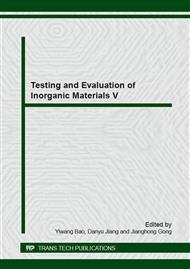[1]
R. Baetens, B.P. Jelle, A. Gustavsen, Aerogel insulation for building applications: A state-of-the-art review, Energy and Buildings, 43 (2011) 761-769.
DOI: 10.1016/j.enbuild.2010.12.012
Google Scholar
[2]
M. Koebel, A. Rigacci, P. Achard, Aerogel-based thermal superinsulation: an overview, J. Sol-Gel Sci. Technol., 63 (2012) 315-339.
DOI: 10.1007/s10971-012-2792-9
Google Scholar
[3]
J.L. Gurav, I. -K. Jung, H. -H. Park, E.S. Kang, D.Y. Nadargi, Silica Aerogel: Synthesis and Applications, J. Nanomater., 1 (2010) 1-12.
Google Scholar
[4]
A.C. Pierre, G.M. Pajonk, Chemistry of Aerogels and Their Applications, Chem. Rev., 102 (2002) 4243-4265.
Google Scholar
[5]
X.P. Lu, P. Wang, D. Buttner, Thermal transport in opacified monolithic silica aerogels, High Temperature-High Pressure, 23 (1991) 431-434.
Google Scholar
[6]
K. Fujita, J. Konishi, K. Nakanishi, Strong light scattering in macroporous TiO2 monoliths induced by phase separation, Appl. Phys. Lett., 85 (2004) 5595-5597.
DOI: 10.1063/1.1823596
Google Scholar
[7]
J. Zhu, J. Xie, X. Lu, D. Jiang, Synthesis and characterization of superhydrophobic silica and silica/titania aerogels by sol-gel method at ambient pressure, Colloids and Surfaces A: Physicochem. Eng. Aspects, 342 (2009) 97-101.
DOI: 10.1016/j.colsurfa.2009.04.016
Google Scholar
[8]
J. Feng, D. Chen, W. Ni, S. Yang, Z. Hu, Study of IR absorption properties of fumed silica-opacifier composites, J. Non-Cryst. Solids, 356 (2010) 480-483.
DOI: 10.1016/j.jnoncrysol.2009.12.015
Google Scholar
[9]
Q. Wang, Z.H. Wen, J.H. Li, A New Hybrid Supercapacitor Fabricated with Carbon Nanotubes Cathode and TiO2-B Nanowires Anode, Adv. Funct. Mater., 16 (2006) 2141-2146.
DOI: 10.1002/adfm.200500937
Google Scholar
[10]
A.R. Armstrong, G. Armstrong, J. Canales, R. García, P.G. Bruce, Lithium-Ion Intercalation into TiO2-B Nanowires, Adv. Mater., 17 (2005) 862-865.
DOI: 10.1002/adma.200400795
Google Scholar
[11]
C.J. Brinker, K. Keefer, D. Schaefer, C. Ashley, Sol-Gel transition in simple silicates, J. Non-Cryst. Solids, 48 (1982) 47-64.
DOI: 10.1016/0022-3093(82)90245-9
Google Scholar
[12]
S. Cui, W. Cheng, X. Shen, M. Fan, A. Russell, Z. Wu, X. Yi, Mesoporous amine-modified SiO2 aerogel: a potential CO2 sorbent, Environ. Sci., 4 (2011) 2070-(2074).
DOI: 10.1039/c0ee00442a
Google Scholar


